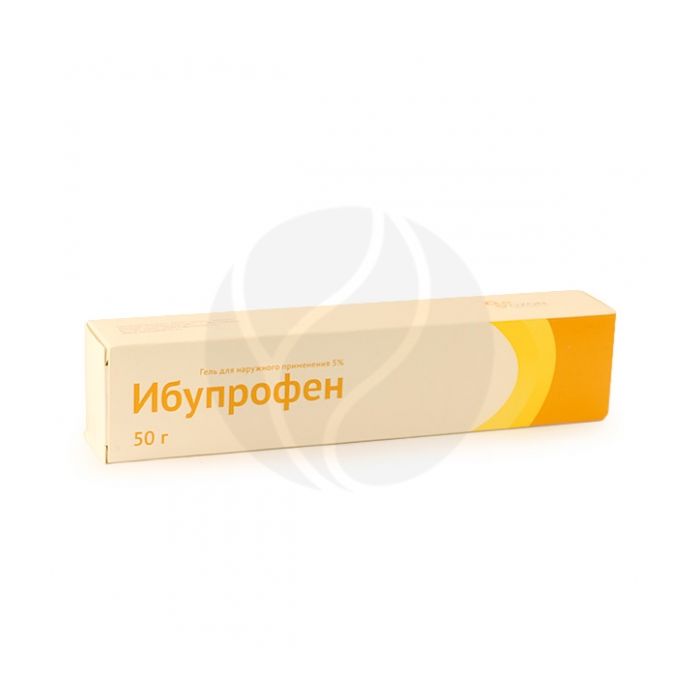Ibuprofen gel 5%, 50 g Ozone
Expiration Date: 11/2025
Russian Pharmacy name:
Ибупрофен гель 5%, 50 г Озон
inflammatory and degenerative diseases of the musculoskeletal system;
arthritis (rheumatoid, psoriatic);
pain syndrome with rheumatism,
with exacerbation of gout;
humerus periarthritis;
ankylosing spondylitis (ankylosing spondylitis);
deforming osteoarthritis;
osteochondrosis with radicular syndrome;
radiculitis;
sciatica;
myalgia (of rheumatic and non-rheumatic origin); lumbago; tendinitis, tendovaginitis, bursitis; injuries (sports, industrial, household) without violating the integrity of soft tissues (including bruises, post-traumatic edema of soft tissues).
Outwardly. For adults and children over 12 years old, a strip of gel 4-10 cm long (corresponding to 50-125 mg of ibuprofen) is applied to the affected area and rubbed thoroughly with light movements until completely absorbed. Re-use of the drug is possible only after 4 hours and no more than 4 times a day. The required amount of the drug depends on the size of the painful area.
For children from 6 to 12 years old, a strip of gel 2-4 cm long is applied to the affected area no more than 3 times a day.
The duration of treatment is 2-3 weeks.
Active substance: ibuprofen
increased individual sensitivity to ibuprofen or other components of the drug, including other NSAIDs;
hypersensitivity to acetylsalicylic acid and other NSAIDs, manifested by an attack of bronchial asthma or other allergic reactions;
weeping dermatoses, eczema;
violation of the integrity of the skin (including infected wounds and abrasions);
children's age (up to 6 years old),
pregnancy (III trimester).
Caution should be exercised in hepatic porphyria (exacerbation), erosive and ulcerative lesions of the gastrointestinal tract, severe violations of liver and kidney function, use in childhood (up to 12 years), pregnancy (I and II trimester), as well as during lactation (breastfeeding) ...
The drug should not be applied to an open wound surface, damaged skin or mucous membranes (avoid contact with eyes). After application, do not apply an occlusive dressing.
After using the drug, wash your hands thoroughly.
pharmachologic effect
Non-steroidal anti-inflammatory drug (NSAID).
Indications for Ibuprofen
inflammatory and degenerative diseases of the musculoskeletal system;
arthritis (rheumatoid, psoriatic);
pain syndrome with rheumatism,
with exacerbation of gout;
humerus periarthritis;
ankylosing spondylitis (ankylosing spondylitis);
deforming osteoarthritis;
osteochondrosis with radicular syndrome;
radiculitis;
sciatica;
myalgia (of rheumatic and non-rheumatic origin); lumbago; tendinitis, tendovaginitis, bursitis; injuries (sports, industrial, household) without violating the integrity of soft tissues (including bruises, post-traumatic edema of soft tissues).
Dosage regimen
Outwardly. For adults and children over 12 years old, a strip of gel 4-10 cm long (corresponding to 50-125 mg of ibuprofen) is applied to the affected area and rubbed thoroughly with light movements until completely absorbed. Re-use of the drug is possible only after 4 hours and no more than 4 times a day. The required amount of the drug depends on the size of the painful area.
For children from 6 to 12 years old, a strip of gel 2-4 cm long is applied to the affected area no more than 3 times a day.
The duration of treatment is 2-3 weeks.
Side effect
Allergic reactions: possibly - bronchospasm (with increased sensitivity to NSAIDs); rarely - flushing of the skin, rash, swelling, burning sensation, tingling or itching of the skin.
Contraindications for use
increased individual sensitivity to ibuprofen or other components of the drug, including other NSAIDs;
hypersensitivity to acetylsalicylic acid and other NSAIDs, manifested by an attack of bronchial asthma or other allergic reactions;
weeping dermatoses, eczema;
violation of the integrity of the skin (including infected wounds and abrasions);
children's age (up to 6 years old),
pregnancy (III trimester).
Caution should be exercised in hepatic porphyria (exacerbation), erosive and ulcerative lesions of the gastrointestinal tract, severe violations of liver and kidney function, use in childhood (up to 12 years), pregnancy (I and II trimester), as well as during lactation (breastfeeding) ...
The drug should not be applied to an open wound surface, damaged skin or mucous membranes (avoid contact with eyes). After application, do not apply an occlusive dressing.
After using the drug, wash your hands thoroughly.
Application during pregnancy and lactation
The drug should not be used in the third trimester of pregnancy. Use with breastfeeding, in the I and II trimesters of pregnancy is possible after consulting a doctor. Use with caution during lactation.
Application for violations of liver function
Caution should be exercised in severe liver dysfunctions.
Application for impaired renal function
Caution should be exercised in severe renal impairment.
Application in children
Caution should be exercised when used in children (up to 12 years). The use of the drug is contraindicated in children under 6 years of age. Special instructions Influence on the ability to drive vehicles and control mechanisms
The use of Ibuprofen gel does not affect activities requiring increased attention, coordination of movements, high speed of mental and physical reactions (including those of transport drivers, persons serving cars).
Overdose
Symptoms: when applying large amounts of gel on a large surface of the skin or getting into the oral cavity, there may be abdominal pain, nausea, vomiting, drowsiness, headache.
Treatment: the remains of the gel should be removed from the surface of the skin or from the oral cavity. If large amounts of the drug enter the oral cavity, gastric lavage, the use of saline laxatives and symptomatic therapy are indicated.
Drug interactions
No clinically significant interactions with other drugs have been described.
May enhance the systemic effect of other NSAIDs taken orally.

